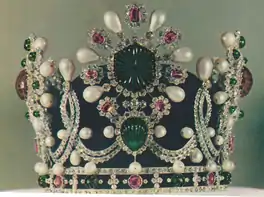

Baroque pearls are pearls with an irregular, non-spherical shape.[1][2] Shapes can range from minor aberrations to distinctly ovoid, curved, pinched, or lumpy shapes. Most cultured freshwater pearls are baroque because freshwater pearls are mantle-tissue nucleated instead of bead nucleated. Cultured saltwater pearls can also be baroque, but tend to be more teardrop-shaped due to the use of a spherical nucleation bead.
The most valuable baroque pearls are the South Sea and the Tahitian pearls, which are produced by Pinctada margaritifera (black-lipped oysters) and Pinctada maxima (gold-lipped and white-lipped oysters). Although these are a variety of cultured saltwater pearls, the amount of time that the pearls are cultured dramatically increases the depth of the nacre, and the likelihood of producing a baroque pearl. Most Tahitian pearl farm harvests, which, for example, produce more than 40 percent baroque and semi-baroque pearls. Western Australia is currently the world's largest cultivator of pearls from Pinctada maxima gold-lipped oysters, whereas Tahiti is the number one cultivator of pearls from Pinctada margaritifera black-lipped oysters.
References
- ↑ Watson, Cate (2008-01-01). Reflexive Research and the (Re)Turn to the Baroque: Or, how I Learned to Stop Worrying and Love the University. BRILL. pp. 4–5. ISBN 978-90-8790-642-9.
- ↑ Manutchehr-Danai, Mohsen (2013-03-09). Dictionary of Gems and Gemology. Springer Science & Business Media. p. 38. ISBN 978-3-662-04288-5.